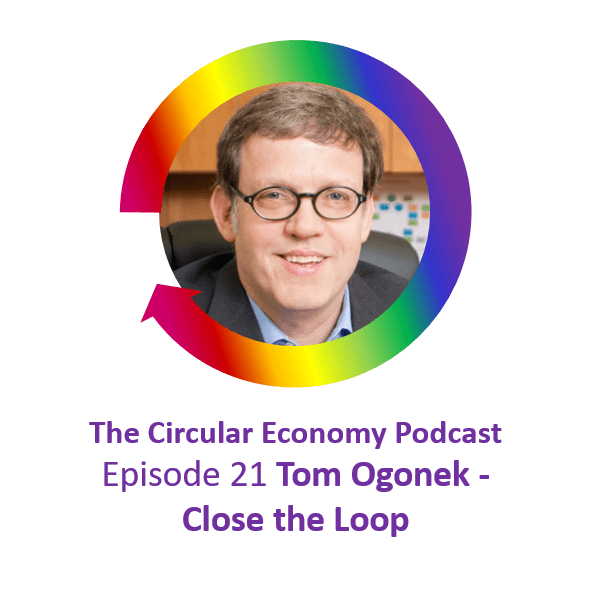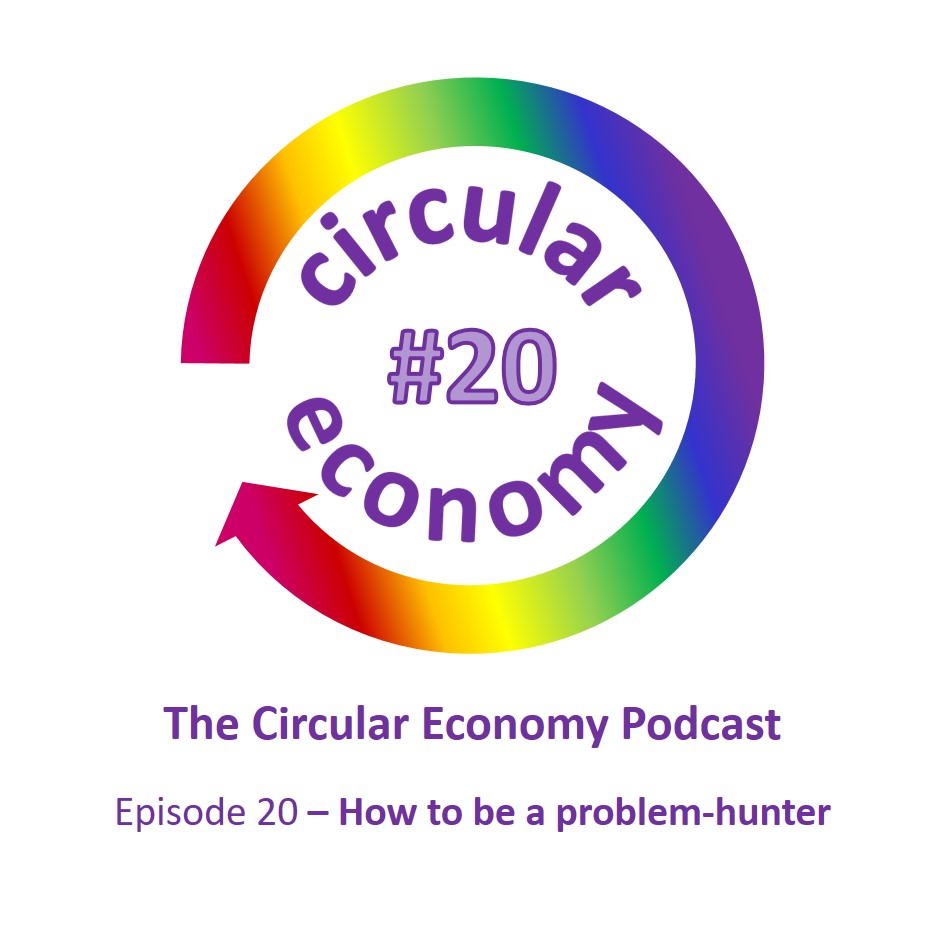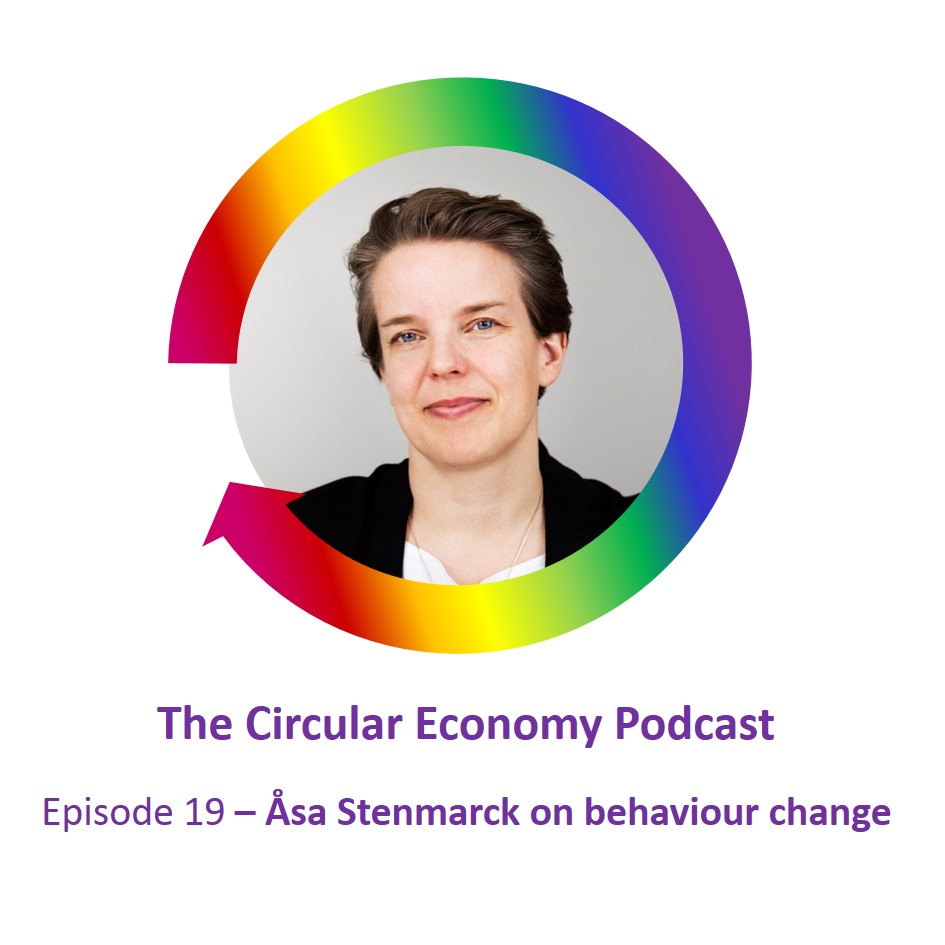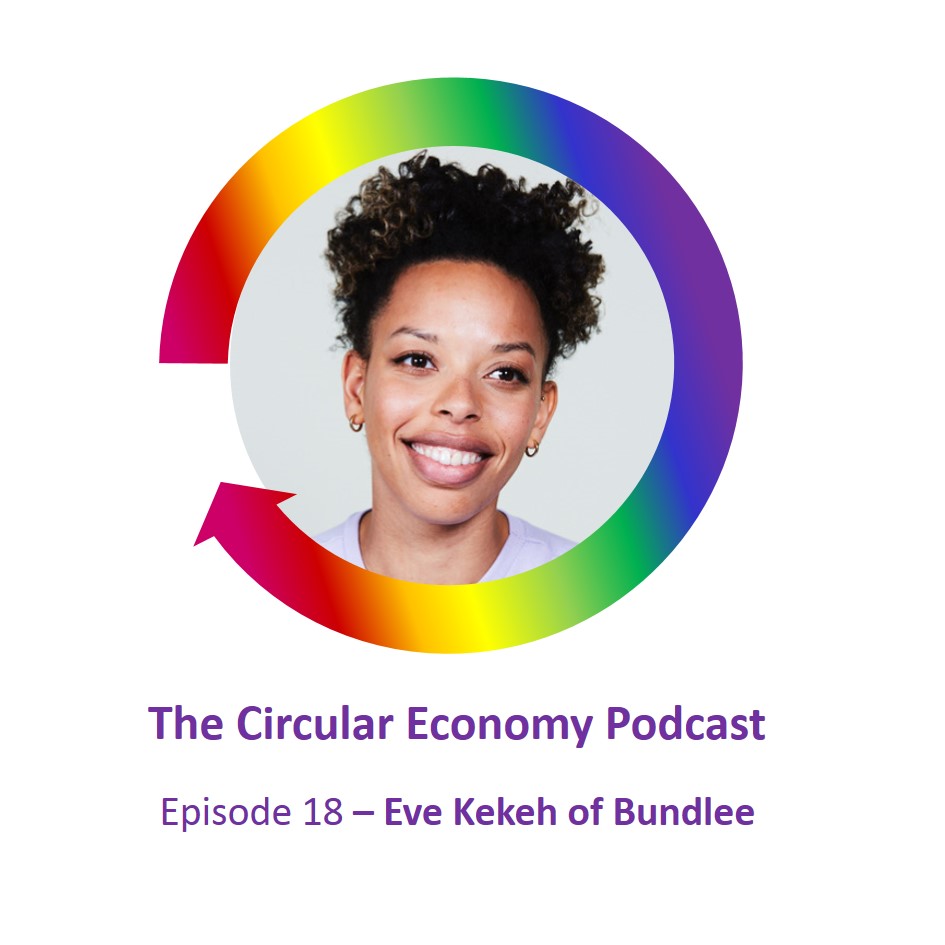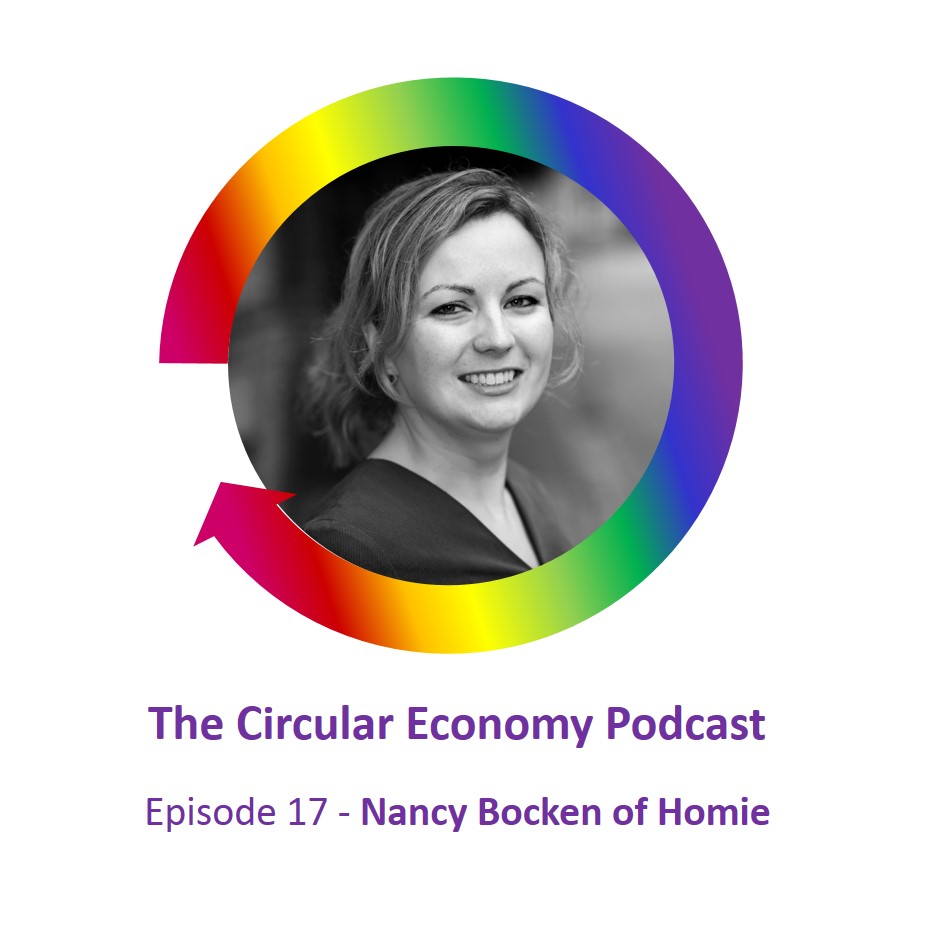Podcast: Play in new window | Download
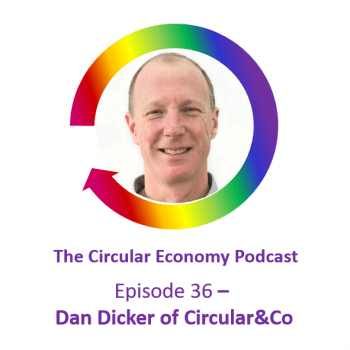 In this episode, Catherine talks to Dan Dicker, Founder and CEO of Circular&Co, the new brand name for ashortwalk Ltd and rCUP®.
In this episode, Catherine talks to Dan Dicker, Founder and CEO of Circular&Co, the new brand name for ashortwalk Ltd and rCUP®.
Dan began his career as a product designer at Dyson, but had a strong desire to live and work a short walk from the sea. So, back in 2003, Dan founded a pioneering Circular Design practice ‘ashortwalk’. Now Circular&Co invent solutions that keep our materials and finite resources in use for as long as possible, whilst preventing them from ever reaching landfill or our oceans.
As well as their range of award-winning products available across 38 countries, they advise, develop, and deliver circular solutions for global brands worldwide, reinventing today’s waste into tomorrow’s Circular products.
We discuss Dan’s design approach, and how Dan believes that businesses going circular have everything to gain financially, as well as environmentally.
Podcast host Catherine Weetman is a circular economy business advisor, workshop facilitator, speaker and writer. Her award-winning book, includes lots of practical examples and tips on getting started. Catherine founded Rethink Global in 2013, to help businesses use circular, sustainable approaches to build a better business (and a better world).
Stay in touch for free insights and updates…
Read on for a summary of the podcast and links to the people, organisations and other resources we mention.
You can subscribe to the podcast series on iTunes, Google Podcasts, PlayerFM, Spotify, TuneIn, or search for “circular economy” in your favourite podcast app. Stay in touch to get free insights and updates, direct to your inbox…
Links we mention in the episode:
- There are some places left for Catherine’s free webinar on Thurs 1st October, looking at circular economy examples for fashion, housing and local communities, for Berwick Educational Association, supported by the RSA. – sign up here: https://www.eventbrite.co.uk/o/berwick-educational-association-13564670646
- Dan Dicker on LinkedIn https://www.linkedin.com/in/dan-dicker-8a0616146/
- Circular & Co https://circularandco.com/
- @CircularandCo on Instagram, Twitter and Facebook
- Gavin Christman of Green & Blue Build https://greenandbluebuild.co.uk/
- Episode 33 – Greg Lavery of Rype Office https://www.rethinkglobal.info/episode-33-greg-lavery-of-rype-office/
- Ep 24 – Steve Haskew of Circular Computing https://www.rethinkglobal.info/episode-24-steve-haskew-of-circular-computing/
About Dan Dicker
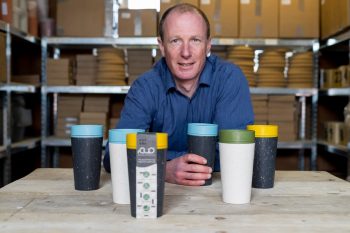 Dan Dicker is Founder and CEO of Circular&Co. (formerly rCUP® and ashortwalk Ltd. )
Dan Dicker is Founder and CEO of Circular&Co. (formerly rCUP® and ashortwalk Ltd. )
Dan began his career as a product designer at Dyson. Following a desire to live and work a short walk from the sea, in 2003, Dan founded pioneering Circular Design practice ‘ashortwalk’. With 17 years of experience leading at the forefront of circular product design, Circular&Co. invent solutions that keep our materials and finite resources in use for as long as possible, whilst preventing them from ever reaching landfill or our oceans.
As well as their range of award-winning products with a network distribution spanning across 38 countries, they advise, develop, and deliver circular solutions for global brands worldwide, reinventing today’s waste into tomorrow’s Circular products.
Now more than ever the future requires solutions. The Future is Circular.
What we talk about
Add 3:10 to these times
Catherine Weetman 00:05
Today I’m talking to Dan Dicker, the founder and CEO of Circular&Co., the new brand name for a short walk, limited and arc up. Dan began his career as a product designer at Dyson, but had a strong desire to live and work a short walk from the sea. So back in 2003, Dan founded a pioneering circular design practice a short walk. Now Circular&Co invent solutions that keep our materials and finite resources in use for as long as possible, whilst preventing them from ever reaching landfill or our oceans. As well as their range of award winning products available across 38 countries, they advise, develop and deliver circular solutions for global brands worldwide, reinventing today’s waste into tomorrow’s circular products. Dan, welcome to the circular economy podcast.
Dan Dicker 00:58
Thank you very much. Yes, very much. Appreciate Thanks for having us on.
Catherine Weetman 01:01
Yeah, it’s great. It’s great to meet you. I’ve, I think I mentioned in our email exchanges that a short walk has been on my surgery company database for four or five years and had a look at what you were doing back then. And it’s great to see all the different products that you’ve been designing since then. And looking at your website, or let’s say I love the circular checklist on the on the web pages: “choose recycled, challenge longevity, check recyclable”. Is that message resonating with people?
Dan Dicker 01:36
And do you know what, that’s something that we’ve come up with very recently, actually. We’ve undergone as you mentioned, the rebrand recently where we’ve moved from being ‘a short walk limited’ to Circular&Co. And that that’s fundamentally because we believe the future is circular. You know, absolutely passionately. We’ve changed our They’re not just our whole brand, but our ethos and everything towards being circular. We think it is the way everything is going to shift. And we want to be part of that we want to try and pioneer that. So that checklist was was an attempt by us really, internally to start thinking about how do we cater to consumers about not just what being circular is all about? And what is the circular economy because it is a broad abroad and quite complex subject, but it’s also how do we enable people to engage in it, which I think is is going to be vital moving forward. So that the answer is I’m not quite sure yet. But we will get there. We’ll let you know. It’s very new.
Catherine Weetman 02:42
Yeah, I really like it. And the message that goes alongside that checklist says, we all have a choice despite what’s in front of us. If it isn’t matching up to your circular checklist, then scroll on to the next page. There’s always a next page, you have that power. And that sort of resonates with a message that I liked. Give which is you know, we have the power of the of the pound in our pocket the money in our pocket, and we should use that to encourage and force change with with businesses. And I think we forget that then we tend to just think that we get what we’re given and forget that we have the power of our of our spending, spending money
Dan Dicker 03:22
And I think it is even more relevant. Now in a digital age where, you know, you’re not limited by choice, the choice is vast. And if things don’t match up to your expectations, you can, you can move on, it’s in your fingertips now, isn’t it years ago, you were limited. And you could only really take what you were given whereas now I think you have that ability to, to search and scroll on and find those products that that you believe in, though that you think are important. And you know that there’s an element of not being lazy for individuals, you know, it’s easy to do the quick Search and just plump for something, and it’s just taking that little bit of extra time to see if, if you can find better. And, you know, now more than ever, it’s not just critical, but it’s a bit easier for people. And I think there’s a, you know, there’s a chicken and egg situation with that scenario, what we’re saying to people look, you know, if it’s not good enough, move on to the next thing, but obviously people can only move on to what they’re also given. And there is still fundamentally a lack of products out there that are ticking that checkbox, you know, there’s not many products made from waste materials. There’s not many products made for longevity, because a lot of business models are sadly looking at, you know, almost the polar opposite from a from a model perspective. And, and then there’s certainly a very few products out there that are designed to be recycled at the end of the day. Like, you know, when we talk about recycle, a lot of businesses hide behind the phrase recyclable. You know, they’ll say yes, it’s recyclable, but there’s a big difference between recyclable and and suddenly can actually physically be recycled within the infrastructure that we’ve got in this country or other countries. So,
Catherine Weetman 05:07
and also recycled, where it’s likely to be consumed, you know, it’s okay having something that could go in your household recycling. But if you’re likely to use that, on the go or out doing sports or whatever, how easy is it for you to get it recycled out there?
05:25
Yeah, completely.
Catherine Weetman 05:27
Yeah. And so how much do you think the push for circular needs to come from us, as citizens and consumers?
Dan Dicker 05:34
And I think now more than ever, because I think, you know, we, we kind of we’ve been designing products out of waste materials for 17 years. So, you know, we kind of when we say, Oh, we’ve we’ve helped to pioneer a circular movement, it was quite naively, it wasn’t a conscious decision. 17 years ago, it’s just we we believe. Now I used design products for Dyson and when I was at Dyson, I thought we could be doing this better, I was aware of technology where we could make certain products out of waste materials. But for what, for logical reasons back then we weren’t. So when I left. And I, you know, that was one of the key pillars for us is to, is to always make waste make product from waste material. So we’ve been doing it a long time. And over that period, you know, the circular economy has kind of grown and grown and grown, but it’s been in largely academia, big industry and government levels. And it’s not yet got to consumers. And but the key the key aspect of closing this loop and becoming circular is to involve consumers and we talked about the power they have, with time and time again. You know, there’s so many examples where change hasn’t really occurred until it’s been led by consumers and demand. So you can scream and scream at big industry and businesses to sway please make your products out of waste materials but if they don’t have to, they kind of won’t, you know, and that’s not necessarily born out of laziness. It’s born out of other constraints. And everybody’s busy and it’s harder to do it. And it’s not necessarily more expensive, but it’s definitely harder. So companies don’t prioritise it until they’ve almost been almost been pushed. And works example actually is one of the products that we do and you mentioned the circular cup it was was called the rCup, but with the brand changes it’s now circular, you know that that actually only came about we weren’t consciously looking at designing that product. But we were asked and because of because of consumer demand, so three, two and a half three years ago, Hugh Fearnley Whittingstall, on the BBC did a programme around the cups. It was very well publicised, and really about how the public were being deceived and everyone thought that paper cups were being recycled because there was a recycling logo on there. And when in reality and this goes by back to our reusable conversations like, Yes, they are recyclable. Sorry, recycled, they are recyclable, but they weren’t being recycled, because it wasn’t an infrastructure built around it to do it. And so off the back of that, that sort of coffee industry, the big players in the coffee industry kind of approached, approached us and said, you know, we need to solve this problem. And can you think of circular ways to do that. And so that’s when it came to our attention. And we looked at how we could potentially recycle paper cups in a in a more in a far more simple way. less energy consumption and not having to separate the inner liner of the paper count. And then once we once we’re done cracked out with some of our some of our partners, and the obvious product to then do was a reusable because obviously, it puts, you know, an incentive back on the consumer that you’re not just trying to eliminate paper cups but by adopting a reusable and But that also helps. So it wasn’t something that was on our radar at all. But that was led that was fundamentally led by an awareness campaign. And then consumers demanding better. That was the only reason I believe that the big industry kind of moved on it. And that’s a really good, I will change comes about.
Catherine Weetman 09:22
Yeah, it’s interesting how that kind of we kind of assume a level of knowledge about things. And it’s just not there. I saw some research. I think it was by IHG bank that said, People expect business to be doing the right thing anyway. And the kind of shocked to find out that they’re not and I guess, you know, those of us who use paper cups 5, 10, 15 years ago, sort of assumed that that coating on the inside was probably wax or something else. You know, would just get recycled as part of the recycled paper recycling process. But once you find out, it’s actually a separate, very thin plastic liner, you then realise that it’s not going to go through the mix paper recycling and that actually you’ve got something that looks benign and it and it’s not at all. And I think that’s that was the, the key to Hugh Fearnley Whittingstall’s programme was getting people to understand that something that looked innocuous just wasn’t at all and could be contributing to microfibers in in the oceans and all the rest of it. So yeah. And then, on the website, I noticed that after 10 years use, which is itself a, you know, a durable cup, isn’t that but after that people can return the cup to you to be recycled and regenerated into another circular cup. So can you tell us a bit about how that works?
Dan Dicker 10:55
Yeah, sure. And that that’s, you know, the key the key to circular economy. Is that is that kind of N bit, I think a lot of companies say they’re circular, because they just make products out of waste material or turn it, and then turn that waste into another product and then tend to think the job’s done. And when actually, you know, the whole purpose of circular economy is you keep that cycle going on and on and on and on. And every time importantly, every time there’s a cycle, you try and increase the value of that resource and material rather than decrease it. Whereas at the moment, a lot of people, you know, they perhaps recycle once, turn it into something else that actually has a lower value, and then can’t get recycled again. So it’s a lost opportunity. So that’s the focus and key. And so I think, you know, our attempt, a tape back scheme is an attempt for us to recapture that material and have it back to us so that we can turn it back into a new product. And technically, it’s not particularly hard. So the big the big challenge When we look at our waste streams internally as a company, the big bit of the time, the big challenges that as soon as you’ve made a product and sold it and kind of release it onto the market, you’ve lost control of that material in someone else’s hands. So the big challenge is to then try and get it back in and that can that can be by the company and saying that we’ll we’ll take it back, or obviously it can be through infrastructure in the UK or whatever country you’re in, you know, ideally, there’d be a right bin somewhere for you to put it in or at the end of its life. You can put it in your curbside recycling, and it will go through the system. And but the foolproof way is to say like, well, we’ll please have it back. And certainly, some companies might think, well, that’s going to be costly, you know, what can we really offer that but again, circular economy principles is that that material has value. And it’s not, it is more cost effective to get that material back and reuse it again and it would be to invest in virgin materials. So, there’s, there’s, there’s, from a financial perspective, there’s everything to gain as well as an environmental. So I think a lot of companies don’t haven’t quite clued into that. And as, as we know that sacred economy really was born out of an economic model to save money, rather than environmental, it just so happens really, as the movements got bigger and bigger. people realise that there are huge environmental benefits from a circular economy, but fundamentally, what underpins it all is is is a way of saving money. So I think whether you’re a small business or a huge global corporate, it’s the if we talk about a penny dropping moment, very often when we advise bigger companies about becoming circular, it’s only it’s only when the penny drops around the economics that they’re thinking, well, this, I can’t believe we’ve not even started to look at this yet. And so, so sorry, going back to your original question, you know, the tape back scheme that that is huge benefits to us doing that from environments environmental perspective, but we also get the material back and it’s easier just to quite literally re grind that material and make it straight back into another camp.
Catherine Weetman 14:15
It’s all about designing with the end in mind, isn’t it that if you’ve if you’ve designed the product and thought about the bill of materials, knowing that you want to recover the, the products at the end of its useful life and make it back into something of equivalent value, then you can put the right design criteria in place. But if you design and and just assume you’re never going to see it again, then that leads you down a different path.
Dan Dicker 14:45
Oh massively. And I think that’s that’s kind of what’s been going wrong. Really. In all honesty is is most even now most products are designed without that aspect in mind at all. It’s kind of a, an over the wall approach really. you design it, make it and sell it and then Effectively don’t want to really hear about it again. And I think and I think, you know, I really believe that legislation will catch up with them longer term. And any company that still dealing in that model now will eventually get caught out sooner rather than later. I do. I do think there will be those companies that that look to become circular. Now we’ll be at the forefront a time where we’ll be forced to do it anyway. So any company not looking at it is is Living Dangerously. I think your won’t be long until you’ll be responsible for what you put on the market and have to have it back or have things in place to be able to for it to be recycled within existing infrastructure.
Catherine Weetman 15:44
Yeah, I think you’re right when you know, it’s the extended producer responsibility legislation that we need. And, you know, the statistic that always shocked me was finding out that even though we have levers in place for all the packaging that’s put on the market In the UK, under the European Union legislation, that the money that comes back from that only pays for about 10% of the cost of the collection and recycling by local councils. So that’s ridiculous, isn’t it? How are you ever going to encourage companies to do something better with packaging? And how are you ever going to fund a better recycling infrastructure? Yeah, it just seems, you know, really short sighted. Yeah, you’re saying that circular enco designs, other products, too, not just the ones that are for sale on your website, but you’re designing for commercial clients. So of the products you’ve designed over the last 17 years, which ones are you most proud of?
Dan Dicker 16:47
That’s, that’s a good question. Yeah, no, I think on a personal level, you know, the real value and the reason I got into design is that you’re taking a something that’s an idea In your head when you’re sat in the bath or sat on a train, which seems to be trains, by the way, I think I think the more we can get back to trains, the more creativity will start flowing through this, this great nation of ours. And, you know, I can’t I can’t. I think every good idea we have comes from sitting on a train. You can’t concentrate on a car in a car can you know, new car stifles innovation? So bring back the trains quickly. But so and yeah, in terms of from a design perspective, I think the cup the reusable circular cup has been brilliant because it people have really engaged with that and people really, really enjoy it. And from a social perspective and social media, we always get such positivity and I still remember the day when we saw a cup, our first cup being held by a member of the public in extra service stations with my with my two lads, you know when they came running over to me “Daddy, Daddy, there’s someone over there with a with an R cup” (as it was called then), you know, and it was really exciting because that was that was just an idea in our head. And then 18 months later, there’s someone using it and, and doing good with it. So you know that that’s been especially proud because we’ve seen it right through from just a thought in our head to people using it, it made it makes a difference. But then we’ve done other ranges as well that we’ve been proud of where we did, we did a load of a range of products made from plant ports, recycle plant pots, and for garden centres. But then at the same time we instigated a collection service so that if you if a customer could come in and drop off their old pose, and let’s face it, we’ve got hundreds of them in our garden sheds or stacking up and you could drop your old pops off and at the same next to the bin where you drop them off would be a range of products made from those exact pops that you know that you’re dropping off and that That was really, we’re really proud of that, because again, it was a sort of Penny dropping moment for consumers and people like me, you know, these are parts that are just piling up in my shed, they’ve got value in use, and they can be turned into something really nice and beautiful. And, you know, I think it’s important to design products. Now that the cup, you know, won lots and lots of awards, and it won the witch award. And that’s made from waste. You know, it’s important to show people that just because it’s made from waste does not mean in any way it’s going to be inferior, and it’s still going to be a really good functioning, quality product. So it’s quite, it’s quite proud to, to get that message across to people and products are great for doing that. And when, you know, we advise a lot of other companies and we we often say a lot, you know, nothing says it better than a product that you’ve got in your hand. Once people realise that they can see it for themselves and then they start believing in it. I think there is a I think generally a public tend to be a bit negative around recycling as you mentioned earlier, you know, there’s that slight disbelief, you know, if I do put it in a recycling bin, does it? Does it really get recycled? Or, you know, where does it go? You know, and I think it’s important to show people that does go somewhere and it does get used and then I think they will engage more in their engagement is king. Really? Yeah, just value out there.
Catherine Weetman 20:22
Exactly. Just on the last podcast, Greg Lavery of Rype Office was talking about a recycled material that they’ve been putting on big conference room and boardroom tables, you know, all made out of waste products. And it it looks, you know, they can create different designs with it. It’s not just one, you know, kind of mixed up colour. And the story behind that helps engage people. So he was giving the example of a, you know, solicitor’s office where people might be worried about how much is this going to cost me and all the rest of it and if you, you know, you kind of walk in and you have a conversation. About a recycled table top, it kind of starts to form the relationship between the client and the company. That, you know, you started to think, Oh, you know, these guys care about about something. And you know, it’s much more interesting than, you know, a sort of swanky top end design thing that the customer is thinking, Oh, how much did that cost? Yeah, so yeah, yeah. I think there, you know, we go on, sorry, sorry.
Dan Dicker 21:27
Yeah, I was just gonna say we were when we designed for other brands, we often use it. No, it’s more sometimes it’s more compelling. And I turn it without without sort of giving names away. But if you’re, if you’ve got a restaurant, and we talk about touchpoints for consumers, you know, and you could design some quite fancy high end products made from waste that you can give to people but actually, if you make your hand dryer in the toilets, out waste materials, that’s actually more of a compelling story because it is They filled in, you’re embedding it within everything you’re doing. You know, and I think you’ve got to start earning people’s trust, people don’t engage with you until they trust you in. And some of these bigger brands can be deemed quite, quite negative brands. So, you know, it’s in their interest to, to bring in that trust, but do it in a in a softer kind of way, rather than a big shouting kind of way. It’s just that’s just start doing it. And people will notice you’re doing it, and then start to trust you a bit more. Hmm.
Catherine Weetman 22:30
Yeah, that’s a great point. And so in the 17 years that you’ve been doing circular design, what challenges have you faced as you’ve built up the business?
Dan Dicker 22:42
So it’s a great question I think from from a personal challenges is very business specific challenges. And then there’s kind of industry wide challenges. You know, and I think, at any, any small business when they’re starting, I think If you do have to accept that if you’re going to, if you’re going to get anywhere in the world, you’ve got to start, you have to come at things differently. You can’t just do another me to product and join, join the masses, you know, it’s got to be something different. And whether it’s the way you produce your business model or your products, but so that, in fact, in, in theory, and in practice is going to give you challenges. So I don’t think you can start a business without accepting, you’re going to face some quite serious challenges. And so I guess, you know, think, from a very business perspective and an individual perspective, one thing I’ve learned over the years is that that you can have a very, very profitable, whereas a very great, you can have a really straight line in terms of turnover as your business grows, you know, it turnovers, you know, x a year and it’s it looks all on the right scale, and it’s going upwards, and it looks very sort of linear and it’s like this is really good. But what I have learned is that your profit readability and appending that lit, that very straight line is incredibly flex. It’s a, it’s a huge wavy curve, you know, and you hit these peaks and troughs where, you know, we’re doing really well and making lots of profit. But then of course, you need to reinvest and get more people and more staff and the bigger premises and more tooling, and then and then your trough again into this area where it’s like, oh, Crikey, you know. So, I’ve learned it’s a very steep and wavy curve business. And I think before I started, I didn’t appreciate that at all. And I think you just looked at the turnover and this nice linear line of thought, yeah, that that’s a good healthy business. And so I’ve learned I’ve learned that over the years, and the other challenges from a circular perspective, and has been, I guess, barriers, especially with big industry where we advise big industry, there’s always going to be barriers very often it’s cost initially. There’s a perception that if it’s going to be made out of wasting time materials are circular, designed to be recycled designed for longevity is going to cost more when in reality, it doesn’t. Now we’ve proved time and time and time again, that it’s a win win situation for big business, they’ll get a product made from waste that cost the same, very often just replaces, like for like with what they’re already purchasing anyway. So they’re not having to pay any more for something. They’re getting the same product, but made from their waste and closing the loop. So, you know, 9.5 times out of 10 it’s a complete win win for everybody. And he’s trying to get that across because there’s always these barriers. And don’t get me wrong sometimes has to be a degree of flexibility. Your marketing department might have to accept a new product that is a slightly different colour. You know, there isn’t the, whatever colour they wanted. So you have to get everybody on board from an early from an early stage. So that’s one thing we’ve learned and is get older. stakeholders in that room right at the beginning. So everyone’s aware of the changes that might have to take place or how things might have to be done slightly differently. And, and if you can do that, you’ll, you’ll have a lot more success because very often in an industry, you’ll find that from the CEO is is hugely in favour of becoming more circular and is demanding it. But actually, when you get down further down to the people who then got to try and deliver it, and know that it’s that message gets filtered and diluted as the further it goes down, it seems and that’s definitely one of the challenges. And
Catherine Weetman 26:38
yeah, that’s Yeah, but a great tip. You know, find that try and find the right message for each one of the stakeholders and and think about what other pressures or KPIs do they have to meet and and how does this help them? help them with that? I mean, yeah, the marketing department if it isn’t their perfect colour you That’s possibly a negative, but the positive is, here’s a fantastic story that you can tell about the products or the packaging.
Dan Dicker 27:08
Massively. Yeah. You know, and I think we talked about challenges is it’s good to talk about the positives as well, because, you know, the huge positives in becoming circular is that it’s, it is in our eyes anyway inevitable. So I think if you know, you always want to be out running a business or in a sector that’s always growing, you know, no one really wants to be in a sector that’s shrinking. And there’s absolute hundred percent conclusive evidence that the circular world is just going to keep growing. And so I think, you know, there’s huge opportunities there in terms of becoming part of that, and always being in a in a world that’s moving forward and wanting to grow. And that’s backed inevitably, by legislation, not just consumer behaviour, but now it’s kind of primarily backed by all the boxes that you want to take in sustainable, long term business. So I do urge I do urge people that, you know, it’s a huge opportunity. massive opportunity.
Catherine Weetman 28:06
Yeah, that’s a great point that it’s, you know, it’s becoming the becoming seen as the way to go. It’s kind of, you know, be circular or or be seen as square.
Dan Dicker 28:17
Yeah, definitely. Well, if you look at the statistics is only going to go that way. You know, I think the latest statistics is it this last year was 100 billion hundred billion tonnes of material we consumed and only 8.6% of it turned into something else and reused again, which is no, it’s just painfully obvious that that’s not sustainable. And it’s got to change and will have to change. So legislation will eventually catch up. Yeah, and but but almost going back to our original question, it’s like, while we wait for the big wheels of industry to change, there’s things we can do right now as consumers to start making that change and driving it. So rather than feeling like that, For someone else to deal with, and governments, you know that 8.6 could change quite remarkably by just consumer behaviour. And that’s an overnight thing.
Catherine Weetman 29:11
Yeah, that’s a great point. And going back to the, the message on your website, there’s, there’s always the next webpage, you have the power to power to click on to another page if you don’t. If you’re not happy with what you’re seeing in front of you before you buy,
Dan Dicker 29:25
yeah, yeah, demand better. People can demand better they have that option. I guess people need to be aware of what is better. You know, that culture we’ve been, we’ve been given, you know, we’ve been spoon fed a culture since the Second World War of mass consumption. So people have, you know, that’s what people do. We’ve kind of all been programmed. And we’ve all been apt. I think every one of us has been guilty of a bit of a carefree, carefree consumption over the last few decades without really contemplating what’s going on. And it’s only now which is a huge positive, but it’s only now that everyone’s woke up and thought what But what have we been doing? You know, I can’t, should I really be buying a £10 tent before I go to a festival and then leaving it there, you know, it’s just it seems ludicrous now, really, that we got to that point. And I do think we’ve hit that precipice now where we’re coming down the other side of awareness. It’s only I do believe, after perhaps COVID, because we’ve hit another peak with COVID around single use. And, you know, I think as COVID hopefully touchwood dissipates, and will come over that start heading back down that precipice of mass consumption. And I think, you know, consumers won’t be driven by know how much stuff I can buy, you know, success isn’t driven by how much stuff I’ve got is more driven by how little stuff I’ve got. And I think that will change. Definitely.
Catherine Weetman 30:52
Yeah, I agree. Yeah. Let’s hope it accelerates. So, who would you recommend as a future guest for the pod? caste.
Dan Dicker 31:02
And you know what I’m going to recommend a chap called Gavin Christman who I used to work with a Dyson. And he was in marketing. And he without wanting to be up to live because I was his best man as well. So when but he’s he’s another local company to us that that he designs to make some beautiful products out of waste materials or to do a lot to do with with garden in. But this is a beautiful product called a B brick and it’s designed for bees to nesting. Right. And then and then as we know that bees are struggling at the moment in terms of the declining and they need every help they can get and there’s there’s a beautiful product that we can reuse. It’s made out of waste materials. And and he was my partner in crime. You know, we both moved to corpsman around the same time We both worked in my shed together for a couple of years whilst we tried to set up our businesses. And so when you know he, he’s followed a similar journey to me and he’s doing similar things. So I know he’ll have a similar outlook and is doing some beautiful products that people be interested in. So I definitely recommend.
Catherine Weetman 32:21
So normally what was his surname? I didn’t quite catch that.
Dan Dicker 32:24
Christman Christman, Gavin. And the company is called Green and Blue, Green and Blue.
Catherine Weetman 32:30
Excellent. And then how can people find out more about you and about Circular and Co?
Dan Dicker 32:38
D”you know, the easy answer is to say, you know, obviously, look at our website. But what I also want to say is, hopefully you’ll hear about us, you know, in the next coming years, you know, that’s our mission. And I don’t mean that selfishly. Now. If you look on our website, our mission is to promote the circular economy, not promote ourselves, you know, because we’re that passionate about that being a worker solution to write to write some of the global runs at the moment. And I think we all we, we all need to hear about solutions. We’ve all heard about negativity and what’s wrong, and how bad it is. But right now we need more than ever, we need solutions and positivity and, and we’ve kind of stumbled across a way of doing something that we know works and is a positive solution. So we’re, we just want to promote that. And, you know, we’re the beauty of being a family run businesses that you can have those outlooks and views on things and morals and not your whole focus isn’t on a dividend return at the end of the year. It’s about trying to do good. So hopefully, you’ll hear about us because we’re going to shout out loud and proud about what we’re doing what we want other people to do.
Catherine Weetman 33:47
Brilliant, and the website is Circular and (AND) co, CO, circularandco and I’ll put that link in the show notes so people can find that and I think I’ll be going straight back to the website. Having had a look this morning and spotted a clock that I think would look quite good on on the wall behind me. Yeah,
Dan Dicker 34:08
yeah. Yeah, we do lots. There’s 50 other type of products that we did. So he’s quite, quite a vast range over the years.
Catherine Weetman 34:16
Yeah, looks great. Dan, thank you very much for taking the time to talk to us and tell us about CircularandCo and the new, circular, reusable and recyclable cup. And I wish you every success with the next phase of brilliant circular designs. Thank you.
Dan Dicker 34:33
Thank you. Thank you. It’s much appreciated. Thanks, Catherine.
Want to find out more about the circular economy?
If you’d like to learn more about the circular economy and how it could help your business, why not listen to Episode 1, or read our guide: What is the Circular Economy?
To go deeper, you could buy Catherine’s book, A Circular Economy Handbook for Business and Supply Chains This comprehensive guide uses a bottom-up, practical approach. It includes lots of real examples from around the world, to help you really ‘get’ the circular economy. Even better, you’ll be inspired with ideas to make your own business more competitive, resilient and sustainable.
Please let us know what you think of the podcast – and we’d love it if you could leave us a review on iTunes, or wherever you find your podcasts. Or send us a Tweet: @Rethink _Global.
Podcast music
Thanks to Belinda O’Hooley and Heidi Tidow, otherwise known as the brilliant, inventive and generous folk duo, O’Hooley & Tidow for allowing me to use the instrumentals from the live version of Summat’s Brewin’ as music for the podcast. You can find the whole track (inspired by the Copper Family song “Oh Good Ale”) on their album, also called Summat’s Brewin’. Or, follow them on Twitter.
